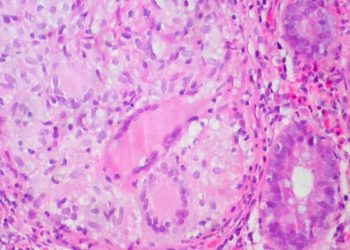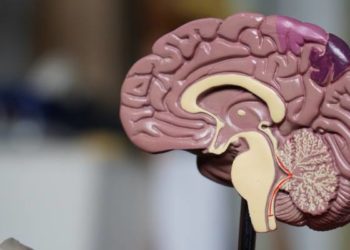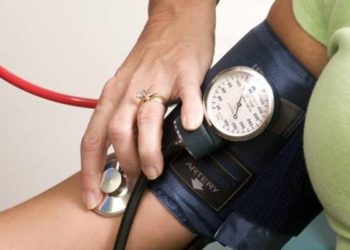2 Minute Medicine Rewind February 12, 2018
Non-Vitamin K antagonist oral anticoagulants (NOACs) provide an alternative to warfarin for patients with atrial fibrillation, but still carry a 0.5% annual risk of intracerebral hemorrhage (ICH). In this retrospective cohort study, 141,311 patients with ICH were followed up to investigate the association between preceding anticoagulant use (warfarin, NOACs, or no oral anticoagulant) within 7 days of hospital presentation and in-hospital mortality. Researchers found that the risk of in-hospital mortality was significantly increased in individuals with preceding warfarin use (adjusted risk difference 9.0%, 97.5% CI 7.9% to 10.1%) and preceding NOAC use (adjusted risk difference 3.3%, 97.5% CI 1.7% to 4.8%) when compared to no prior anticoagulation. However, preceding NOAC use was associated with a significantly decreased risk of in-hospital mortality when compared to preceding warfarin use (adjusted risk difference of -5.7%, 97.5% CI -7.3% to -4.2%). Stroke severity was not significantly different between the three groups. This study therefore shows that NOAC and warfarin use prior to an ICH is associated with an increased risk of in-hospital mortality. However, preceding NOAC use is associated with a significantly lower rate of in-hospital mortality when compared to preceding warfarin use.
Excess weight during childhood is a predictor of adulthood obesity and its associated adverse effects. This cluster randomized controlled trial aimed to investigate the efficacy of a school- and family-based healthy lifestyle program in preventing childhood obesity, as compared to no intervention. Schools across the United Kingdom were selected and 1,397 students in their first year of school, ages 5-6, were enrolled and randomized. Those enrolled in the healthy lifestyle program were exposed to several interventions that encouraged physical activity and healthy diets, including healthy cooking workshops, a six-week program with the Aston Villa football club, and 30 minutes of additional physical activity time at school each day, over the course of 12 months. The primary outcome was the body mass index (BMI) z-score at 15 and 30 months of follow-up. Researchers found no significant difference between the two study arms, with a mean difference of -0.075 when comparing BMI z-score for the intervention arm to usual practice at 15 months (95% CI -0.183 to 0.033, p=0.18) and a mean difference of -0.027 at 30 months (95% CI -0.137 to 0.083, p=0.63). Investigators therefore concluded that healthy lifestyle programs administered in school settings are likely insufficient in addressing the childhood obesity epidemic, underlying the need for wider support across multiple sectors and environments.
Apalutamide Treatment and Metastasis-free Survival in Prostate Cancer
Apalutamide is a non-steroidal anti-androgen that works through competitive inhibition of the androgen receptor and is thus being investigated for efficacy in prostate cancer treatment. In this randomized, double-blind controlled study, 1207 men with non-metastatic castration-resistant prostate cancer and a prostate specific antigen (PSA) doubling time of 10 months or less, were randomized to receive apalutamide 240 mg per day or placebo to study the efficacy of apalutamide in terms of metastasis-free survival. Researchers found that patients in the intervention group exhibited longer metastasis-free survival with a median of 40.5 months, as compared to placebo, for which the median metastasis-free survival was 16.2 months (HR 0.28, 95% CI 0.23 to 0.34, p<0.001). The time to symptomatic progression was also significantly longer in patients receiving apalutamide (HR 0.45, 95% CI 0.32 to 0.63, p<0.001). Apalutamide was, however, associated with a higher rate of adverse events, including rash, hypothyroidism, and fracture. This study therefore shows that apalutamide is associated with a prolonged metastasis-free survival in men with castration-resistant prostate cancer compared to placebo.
Association of Preoperatively Diagnosed Patent Foramen Ovale with Perioperative Ischemic Stroke
Perioperative stroke is an important surgical complication with reported incidence rates ranging from 0.2% to 9.7%. There has been an increasing interest in the association between patent foramen ovale (PFO) and stroke. In this retrospective cohort study, 150,198 patients undergoing non-cardiac surgery were followed up to investigate whether a pre-operative diagnosis of PFO puts patients at an increased risk of this perioperative complication. Researchers found that patients with PFO had a significantly increased risk of ischemic stroke within 30 days of surgery (OR 2.66, 95% CI 1.96 to 3.63, p<0.001). The estimated risks of stroke were 5.9 per 1000 patients with a pre-operative diagnosis of PFO as compared to 2.2 per 1000 patients without a diagnosis of PFO. Patients with PFO were also at increased risk for large vessel territory stroke (RR 3.14, 95% CI 2.21 to 4.48, p<0.001) and stroke resulting in more severe neurologic deficits as compared to the cohort without a diagnosis of PFO. Investigators therefore concluded that patients with a preoperative diagnosis PFO are at an increased risk of perioperative ischemic stroke within 30 days after surgery.
Globally, the incidence of esophageal cancer has increased. While its association with smoking and alcohol use has been well documented, the association between consumption of hot tea and esophageal cancer is currently unknown. In this prospective cohort study, 456,155 patients in China age 30 to 79 years without esophageal cancer at baseline were surveyed to assess tea consumption, lifestyle behaviors, and the temperature at which tea was normally consumed, and followed up to examine whether high-temperature tea drinking, along with the established risk factors of alcohol and smoking, is associated with esophageal cancer risk. New cases of esophageal cancer were documented in 1,731 patients and results showed that those who consumed burning-hot tea daily and more than 15 grams of alcohol daily had a significantly increased risk of esophageal cancer compared to those who drank tea less than weekly and consumed less than 15 grams of alcohol daily (HR 5.00, 95% CI 3.64 to 6.88). In those who consumed more than 15 grams of alcohol per day, there was a significantly increasing risk of esophageal cancer with hotter tea temperature preference (p<0.001 for interaction). Current smokers who drank burning-hot tea daily also had a significantly increased risk of esophageal cancer when compared to non-smokers who drink tea less than weekly (HR 2.03, 95% CI 1.55 to 2.67). In current smokers, there was an increasing risk of esophageal cancer with increasing tea temperature preferences (p=0.001 for interaction). Investigators therefore concluded that drinking tea at high temperatures, when coupled with alcohol use or smoking, is associated with a higher risk of esophageal cancer.
Image: PD
©2018 2 Minute Medicine, Inc. All rights reserved. No works may be reproduced without expressed written consent from 2 Minute Medicine, Inc. Inquire about licensing here. No article should be construed as medical advice and is not intended as such by the authors or by 2 Minute Medicine, Inc.

![2 Minute Medicine: Pharma Roundup: Price Hikes, Breakthrough Approvals, Legal Showdowns, Biotech Expansion, and Europe’s Pricing Debate [May 12nd, 2025]](https://www.2minutemedicine.com/wp-content/uploads/2025/05/ChatGPT-Image-May-12-2025-at-10_22_23-AM-350x250.png)





